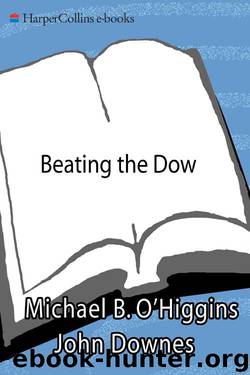Beating the Dow Completely by Michael B. O'Higgins

Author:Michael B. O'Higgins [O’Higgins, Michael with Downes, John]
Language: eng
Format: epub
ISBN: 978-0-062-04358-0
Publisher: HarperCollins
Published: 2000-03-18T16:00:00+00:00
PROCTER & GAMBLE COMPANY (PG)
* * *
Try to guess what happened the year one company said the following in its Letter to Shareholders: “We are reasonably pleasedwith the results of the past year. And yet, as we have stated in previous letters, the long-term development of the business is more important than the results of a single year.”
In most annual reports words like “reasonably” and “long-term” mean things weren’t so hot. But don’t underestimate the modest self-confidence of Procter & Gamble. The annual report from which that quote was taken highlighted an 18 percent increase in earnings and a dividend increase for the thirty-third consecutive year. Now it’s forty-one years. That’s pretty good going.
Procter & Gamble began in 1837 making soap and candles out of pig fat in Cincinnati, then jokingly called “Porkopolis.” The company’s identification with such household staples as Ivory soap, Mr. Clean, Head & Shoulders, Crest, Pampers, Charmin, Bounty and Tide makes it one of the most visible consumer products companies in the world. Not to mention the “soaps” sponsored by P&G, like Search for Tomorrow and As the World Turns, that have fulfilled more than a few fantasies over many years. Although personal care and household products amount to some 80 percent of sales, the company’s food products are equally familiar: Folgers coffee, Crisco, Jif, and Pringles potato chips. The company estimates that 98 percent of American households contain at least one P&G product.
In the fiscal year ended June 30, 1998, laundry and cleaning products contributed 30 percent of the company’s $37.1 billion of sales; paper, 29 percent; beauty care, 19 percent; food and beverage, 12 percent; health care, 8 percent; and corporate and other, 2 percent. North America accounted for 50 percent of total sales and 65 percent of operating profits; Europe, the Middle East, and Africa, for 32 percent of sales and 29 percent of profits; Asia, for 9 percent of sales and 5 percent of profits; Latin America, for 7 percent of sales and 7 percent of profits; and corporate, 2 percent of sales and minus 6 percent of profits.
PG’s success obviously depends on a stream of new products and applications. Olean, for example, a recently approved cooking oil developed in the Food & Beverage segment, is made from soybeans and allows frying without adding fat or calories. The Laundry and Cleaning Products segment has developed Dryel, a fabric care product that enables consumers to clean and freshen clothing labeled “dry clean only” in home dryers. A recently launched face-cleaning cloth combined technological advances from the company’s food, paper, and beauty units.
Download
This site does not store any files on its server. We only index and link to content provided by other sites. Please contact the content providers to delete copyright contents if any and email us, we'll remove relevant links or contents immediately.
| Analysis & Strategy | Bonds |
| Commodities | Derivatives |
| Futures | Introduction |
| Mutual Funds | Online Trading |
| Options | Portfolio Management |
| Real Estate | Stocks |
Pioneering Portfolio Management by David F. Swensen(5640)
Rich Dad Poor Dad by Robert T. Kiyosaki(5204)
How To Win Friends and Influence People by Dale Carnegie(3823)
The Money Culture by Michael Lewis(3319)
The Dhandho Investor by Mohnish Pabrai(3196)
The Wisdom of Finance by Mihir Desai(3114)
Liar's Poker by Michael Lewis(2841)
The Intelligent Investor by Benjamin Graham Jason Zweig(2614)
The ONE Thing by Gary Keller(2556)
Mastering Bitcoin: Programming the Open Blockchain by Andreas M. Antonopoulos(2539)
Investing For Dummies by Eric Tyson(2491)
How to Day Trade for a Living: Tools, Tactics, Money Management, Discipline and Trading Psychology by Andrew Aziz(2484)
How to Win Friends and Influence People by Dale Carnegie(2475)
Rich Dad Poor Dad: What The Rich Teach Their Kids About Money - That The Poor And Middle Class Do Not! by Robert T. Kiyosaki(2456)
Fooled by Randomness: The Hidden Role of Chance in Life and in the Markets by Nassim Nicholas Taleb(2444)
Zero Hour by Harry S. Dent Jr. & Andrew Pancholi(2264)
Market Wizards by Jack D. Schwager(2188)
Rich Dad's Guide to Investing by Robert T. Kiyosaki(2135)
How to Pay Zero Taxes, 2018 by Jeff A. Schnepper(2127)
